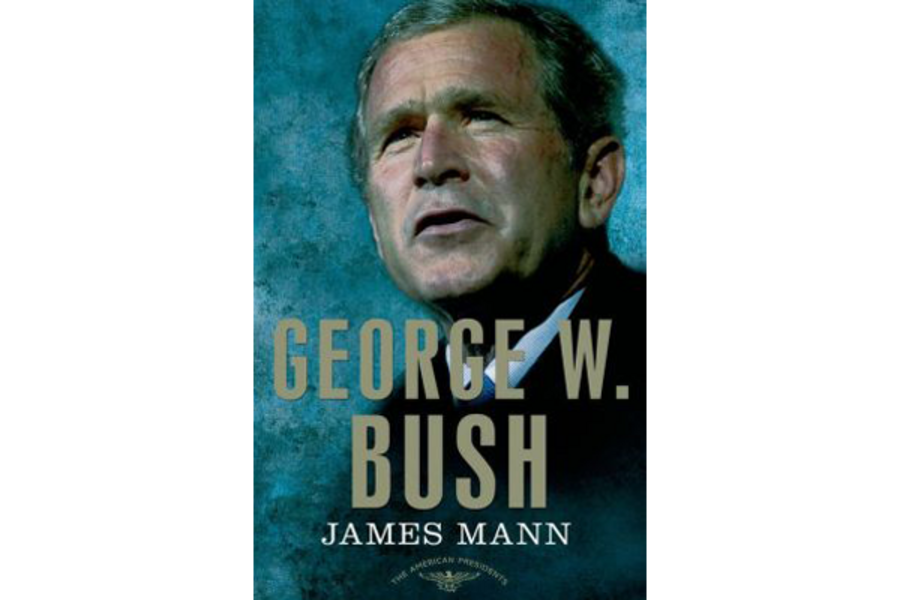'George W. Bush: The American Presidents' assesses the life and work of America's 43rd president
Loading...
George W. Bush left the presidency six years ago. At the time, the United States was involved in two wars and the economy teetered on the edge of another Great Depression. Fellow Republican John McCain had lost the presidential election two months earlier, in part because of fatigue and dissatisfaction with Bush’s two terms in the White House.
The latest installment in the "American Presidents" series of biographies, started by the late Arthur M. Schlesinger and continued under the stewardship of Sean Wilentz, recounts the recent history of the Bush administration with the firm but fair judgment of author James Mann. The series offers brisk biographies of each president in crisp, straightforward prose, a formula Mann follows with precision.
Bush has long said it will take many more years before historians can judge his presidency with proper perspective. Mann writes that that may be the case with surveillance and other counter-terrorism policies.
But on the major issues of any presidency – war and peace – Mann's conclusions are already clear. He labels the Iraq War a “strategic blunder of epic proportions.” Mann notes the Bush administration projected the cost of the war would be under $100 billion, 20 times less than its actual $2 trillion price tag. The war failed to sow the seeds of democracy across the Middle East as promised and took the lives of 4,400 Americans.
As for peace – "it’s the economy, stupid" — Mann deems Bush’s tax cuts to be failures that “strained resources both for the two wars and for other ventures abroad and at home.” Deficits soared, income disparity widened to historic proportions and the hands-off regulatory approach carried out by Bush exacerbated policies passed by Democrat Bill Clinton.
Mann praises Bush for evolving into a more hands-on, moderate foreign policy in his second term while shifting away from the rigid unilateralism of vice president Dick Cheney. During the financial collapse in 2008, Bush abandoned his free-market principles and backed bailouts that prevented even worse circumstances. His best legacy: an ambitious, successful campaign to treat and prevent AIDS in Africa.
Bush, of course, campaigned on “compassionate conservatism” and, after triumphing in the hanging-chad election of 2000, came to the White House expecting to focus on domestic policy. He was expected to be assembling a cabinet and approach continuing the moderate vein of his father, President George H.W. Bush.
Instead, nine months into his first term, the 9/11 terrorist attacks in New York and Washington killed 3,000 people and changed the entire focus of Bush’s presidency. Here, too, Mann makes sure to catalog various perspectives on how the attacks occurred and why (remember the August 2001 CIA memo headlined “Bin Laden Determined to Strike in U.S.”). An obsession with preventing similar, expected attacks took precedence.
“Under Bush, the center of gravity with the Republican Party shifted steadily to the right, and moderates were increasingly marginalized,” Mann writes.
Earlier in the book, Mann sketches the early life of George W. Bush with skill. He makes note of how Bush’s West Texas childhood blended with his elite Eastern roots. Despite his wealth and privilege, and his education at Andover and Yale, Bush always considered himself a Texan and was suspicious of the aristocracy that put him on the path to the presidency.
As much as anything, Mann shows Bush to be a purely political creature. He dabbled without distinction in the oil business, relying mostly on family contacts. Later, some of those contacts helped Bush become a partner and front man for the Texas Rangers baseball team, a position he used to hone his public speaking. And fatten his wallet, converting a personal investment of $600,000 into a $15 million payout when he sold his interest.
In 1978, Bush lost his first race, a Texas Congressional campaign. He went on to work on all three of his father’s presidential campaigns before winning his second run for public office in 1994, defeating Ann Richards to become Texas governor. Six years later, he was elected president.
From the “mistrust and tension between Cheney and [Secretary of State Colin] Powell” to stem-cell research, No Child Left Behind, Supreme Court appointments and rejecting the Kyoto Protocol, Mann hits all the right notes without getting bogged down. Condoleezza Rice, Donald Rumsfeld, Henry Paulson, Alan Greenspan, Ben Bernanke and Paul Wolfowitz, among others, are also shown in their influential moments, good and bad.
For those seeking a comprehensive, fair-minded account of the Bush years, Peter Baker’s “Days of Fire,” an 800-page book published in 2013, remains the gold standard. And for those who want a shorter but equally intelligent look at our 43rd president, Mann is your man.








